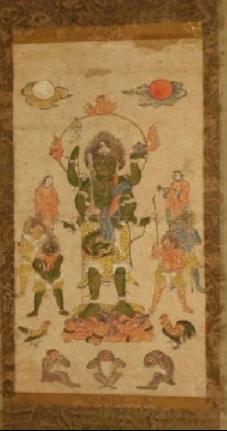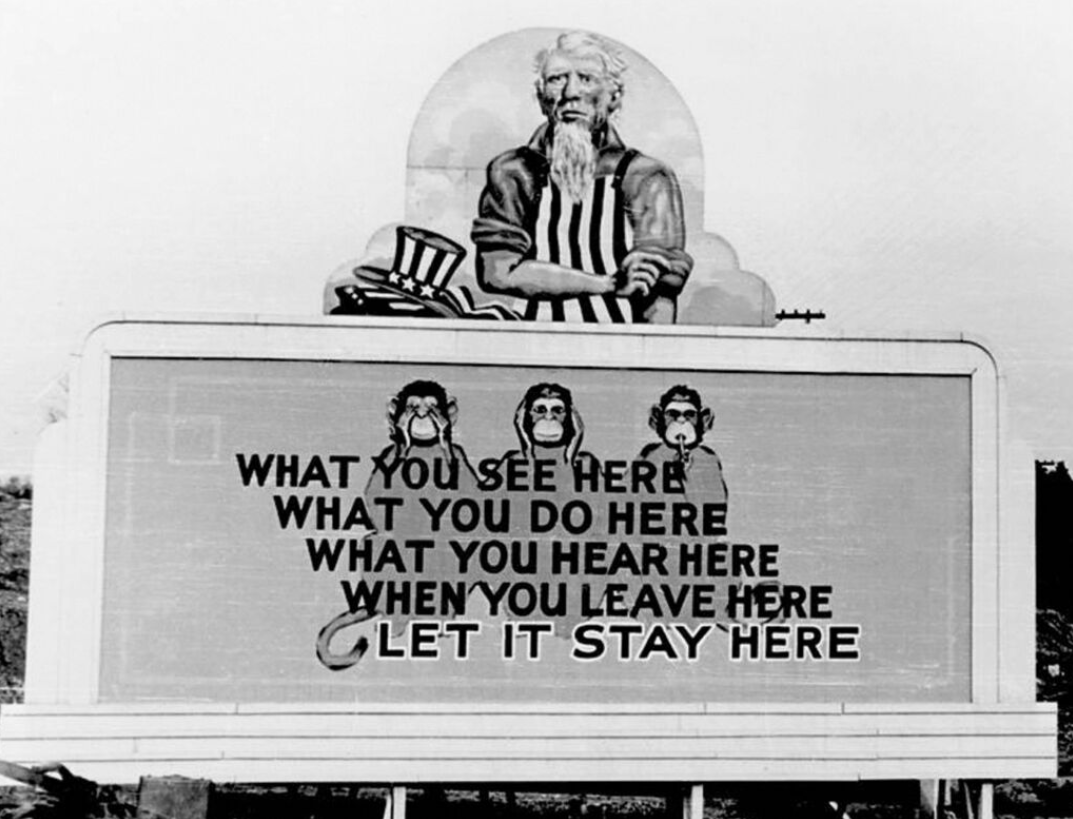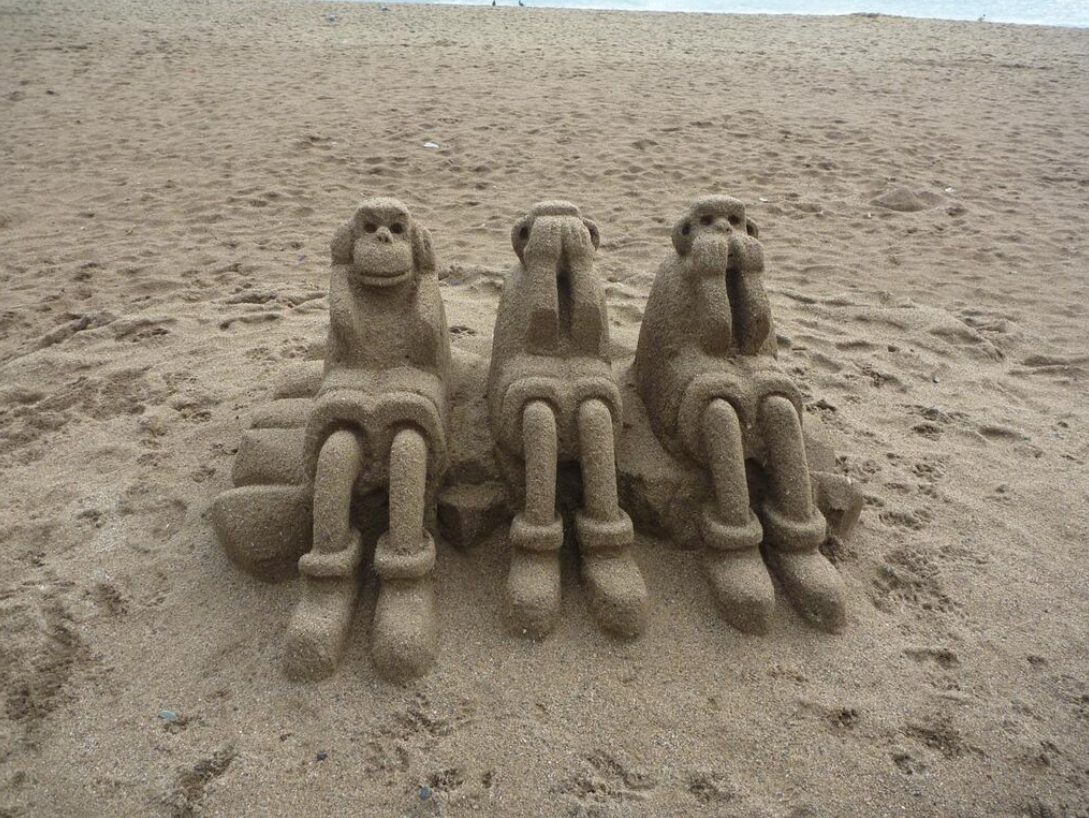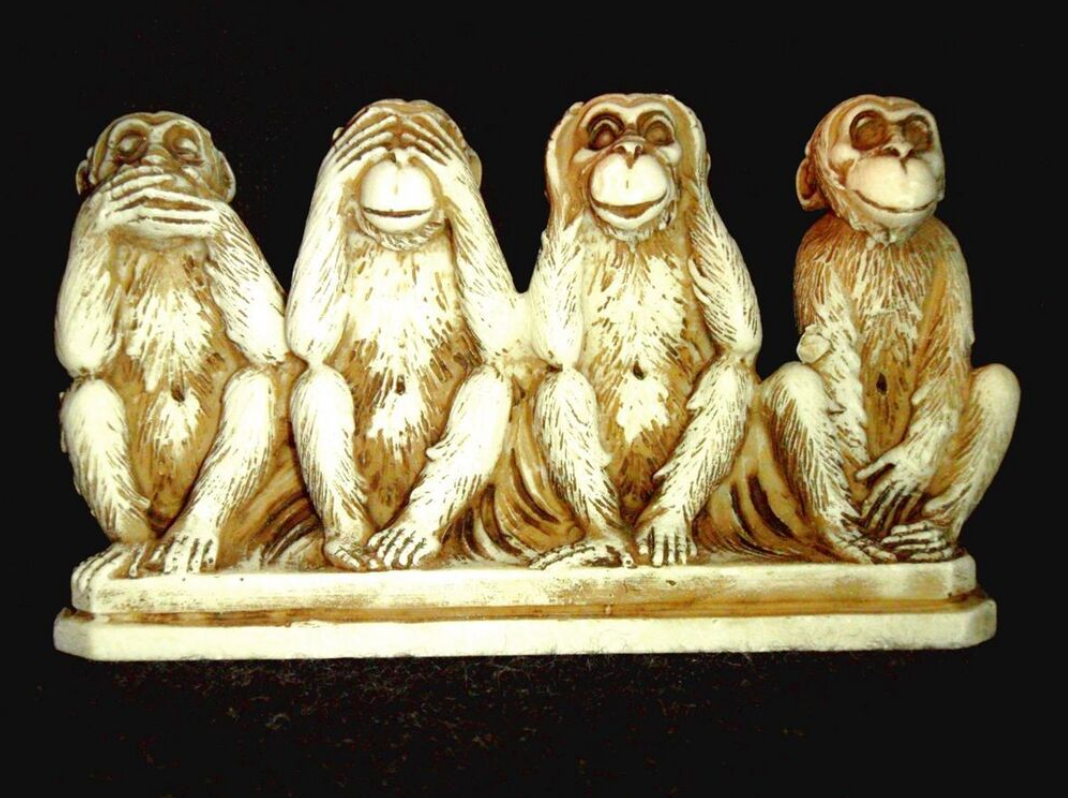The three wise monkeys are a pictorial maxim, embodying the proverbial principle "see no evil, hear no evil, speak no evil". The three monkeys are Mizaru, covering his eyes, who sees no evil; Kikazaru, covering his ears, who hears no evil; and Iwazaru, covering his mouth, who speaks no evil. Lafcadio Hearn refers to them as the three mystic apes in his Glimpses of unfamiliar Japan (volume 2, page 127). There are various meanings ascribed to the monkeys and the proverb including associations with being of good mind, speech and action. In the Western world the phrase is often used to refer to those who deal with impropriety by turning a blind eye. Outside Japan the monkeys' names are sometimes given as Mizaru, Mikazaru, and Mazaru, as the last two names were corrupted from the Japanese originals. The monkeys are Japanese macaques, a common species in Japan.
- iwazaru
- monkeys
- proverbial
1. Origin


The source that popularized this pictorial maxim is a 17th-century carving over a door of the famous Tōshō-gū shrine in Nikkō, Japan . The carvings at Tōshō-gū Shrine were carved by Hidari Jingoro, and believed to have incorporated Confucius’s Code of Conduct, using the monkey as a way to depict man’s life cycle. There are a total of eight panels, and the iconic three wise monkeys picture comes from panel 2. The philosophy, however, probably originally came to Japan with a Tendai-Buddhist legend, from China in the 8th century (Nara Period). It has been suggested that the figures represent the three dogmas of the so-called middle school of the sect.
In Chinese, a similar phrase exists in the late Analects of Confucius from 2nd to 4th century B.C.: "Look not at what is contrary to propriety; listen not to what is contrary to propriety; speak not what is contrary to propriety; make no movement which is contrary to propriety" (非禮勿視,非禮勿聽,非禮勿言,非禮勿動).[1] It may be that this phrase was shortened and simplified after it was brought into Japan.
It is through the Kōshin rite of folk religion that the most significant examples are presented. The Kōshin belief or practice is a Japanese folk religion with Chinese Taoism origins and ancient Shinto influence. It was founded by Tendai Buddhist monks in the late 10th century. A considerable number of stone monuments can be found all over the eastern part of Japan around Tokyo. During the later part of the Muromachi period, it was customary to display stone pillars depicting the three monkeys during the observance of Kōshin.
Though the teaching had nothing to do with monkeys, the concept of the three monkeys originated from a simple play on words. The saying in Japanese is mizaru, kikazaru, iwazaru (見ざる, 聞かざる, 言わざる) "see not, hear not, speak not", where the -zaru is a negative conjugation on the three verbs, matching zaru, the modified form of saru (猿) "monkey" used in compounds. Thus the saying (which does not include any specific reference to "evil") can also be interpreted as referring to three monkeys.
The shrine at Nikko is a Shinto shrine, and the monkey is an extremely important being in the Shinto religion. The monkey is believed to be the messenger of the Hie Shinto shrines, which also have connections with Tendai Buddhism. There are even important festivals that are celebrated during the year of the Monkey (occurring every twelve years) and a special festival is celebrated every sixteenth year of the Kōshin.
"The Three Mystic Apes" (Sambiki Saru) were described as "the attendants of Saruta Hito no Mikoto or Kōshin, the God of the Roads".[2] The Kōshin festival was held on the 60th day of the calendar. It has been suggested that during the Kōshin festival, according to old beliefs, one’s bad deeds might be reported to heaven "unless avoidance actions were taken…". It has been theorized that the three Mystic Apes, Not Seeing, Hearing, or Speaking, may have been the "things that one has done wrong in the last 59 days".
According to other accounts, the monkeys caused the Sanshi and Ten-Tei not to see, say or hear the bad deeds of a person. The Sanshi (三尸) are the Three Corpses living in everyone's body. The Sanshi keep track of the good deeds and particularly the bad deeds of the person they inhabit. Every 60 days, on the night called Kōshin-Machi (庚申待), if the person sleeps, the Sanshi will leave the body and go to Ten-Tei (天帝), the Heavenly God, to report about the deeds of that person. Ten-Tei will then decide to punish bad people, making them ill, shortening their time alive, and in extreme cases putting an end to their lives. Those believers of Kōshin who have reason to fear will try to stay awake during Kōshin nights. This is the only way to prevent the Sanshi from leaving their body and reporting to Ten-Tei.
An ancient representation of the "no see, no hear, no say, no do" can be found in four golden figurines in the Zelnik Istvan Southeast Asian Gold Museum. These golden statues date from the 6th to 8th century. The figures look like tribal human people with not very precise body carvings and strong phallic symbols.[3] This set indicates that the philosophy comes from very ancient roots.
It is not clear how or when the saying travelled; in Ethiopia the Ge'ez language has the saying "Let the eye fast, let the mouth fast, let the ears fast."[4]
2. Meaning of the Proverb

Just as there is disagreement about the origin of the phrase, there are differing explanations of the meaning of "see no evil, hear no evil, speak no evil".
- In Buddhist tradition, the tenets of the proverb are about not dwelling on evil thoughts.
- In the Western world both the proverb and the image are often used to refer to a lack of moral responsibility on the part of people who refuse to acknowledge impropriety, looking the other way or feigning ignorance.[5]
- It may also signify a code of silence in gangs, or organized crime.
3. Variations
Sometimes there is a fourth monkey depicted, Shizaru, who symbolizes the principle of "do no evil". He may be shown crossing his arms or covering his genitals. Yet another variation has the fourth monkey hold its nose to avoid a stench and has been dubbed "smell no evil" accordingly.[6]

3.1. Rajneesh Movement
According to Osho Rajneesh, the monkey symbolism originated in ancient Hindu tradition and Buddhist monks spread this symbolism across Asia. The original Hindu and Buddhist version has four monkeys and the fourth monkey covers his genitals.The Buddhist version means this as "Don't do anything evil".
In Hindu original version the meaning of the fourth monkey is totally different from the popular Buddhist version. It means, "Hide your pleasures. Hide your enjoyment, don't show it to anybody."[7]
Osho Rajneesh gave his own meaning regarding this. The first monkey denotes 'Don't listen to the truth because it will disturb all your consoling lies'. The second monkey denotes 'Don't look at the truth; otherwise your God will be dead and your heaven and hell will disappear'. The third monkey denotes 'Don't speak the truth, otherwise you will be condemned, crucified, poisoned, tortured by the whole crowd, the unconscious people. The fourth monkey denotes "Keep your pleasures, your joys, hidden. Don't let anybody know that you are a cheerful man, a blissful man, an ecstatic man, because that will destroy your very life. It is dangerous".[8]
4. Cultural Influences

The three wise monkeys, and the associated proverb, are known throughout Asia and in the Western world. They have been a motif in pictures, such as the ukiyo-e (Japanese woodblock printings) by Keisai Eisen, and are frequently represented in modern culture.
Mahatma Gandhi's one notable exception to his lifestyle of non-possession was a small statue of the three monkeys - Bapu, Ketan and Bandar. Today, a larger representation of the three monkeys is prominently displayed at the Sabarmati Ashram in Ahmedabad, Gujarat, where Gandhi lived from 1915 to 1930 and from where he departed on his famous salt march. Gandhi's statue also inspired a 2008 artwork by Subodh Gupta, Gandhi's Three Monkeys.[9]
The three monkeys are depicted in the trial scene in the 1968 Planet of the Apes. An example of semiotics, as the judges mimic the see no evil, hear no evil, speak no evil monkeys.[10]
The maxim inspired an award-winning 2008 Turkish film by director Nuri Bilge Ceylan called Three Monkeys (Üç Maymun).
5. Unicode Characters
Unicode provides emoji representations of the monkeys in the Emoticons block as follows:[11]
- Mizaru: U+1F648 🙈 SEE-NO-EVIL MONKEY
- Kikazaru: U+1F649 🙉 HEAR-NO-EVIL MONKEY
- Iwazaru: U+1F64A 🙊 SPEAK-NO-EVIL MONKEY
The content is sourced from: https://handwiki.org/wiki/Biology:Three_wise_monkeys
References
- Original text: 論語 (in Chinese), Analects (in English)
- Joly, Henri L. (1908). "Legend in Japanese Art". London, New York: J. Lane. p. 10. https://archive.org/stream/legendinjapanese00jolyuoft/legendinjapanese00jolyuoft_djvu.txt. Retrieved 13 December 2011.
- Cultures and Civilisations in Southeast Asia. Private museum in Budapest, Hungary. http://www.zelnik-collection.com
- Afeworq Tareqeny. 2008 (Ethiopian calendar). Anəggarä məsale zägə'əz. Addis Ababa. p. 9.
- Tom Oleson (29 October 2011). "How about monkey see, monkey DON'T do next time?". Winnipeg Free Press. http://www.winnipegfreepress.com/opinion/columnists/how-about-monkey-see-monkey-dont-do-next-time-132842328.html. Retrieved 25 July 2012.
- Pornpimol Kanchanalak (21 April 2011). "Searching for the fourth monkey in a corrupted world". Thailand. Archived from the original on 28 August 2015. https://web.archive.org/web/20150828032149/http://www.nationmultimedia.com/home/2011/04/21/opinion/Searching-for-the-fourth-monkey-in-a-corrupted-wor-30153534.html. Retrieved 19 June 2017.
- Osho, Chandra Mohan Jain. "I Celebrate Myself: God Is No Where: Life Is Now Here". http://www.oshorajneesh.com/download/osho-books/zen/I_Celebrate_Myself.pdf.
- Osho on zen. "I celebrate myself: God is no where, Life is now here". Chapter 1: The grand Rebellion. Question 1.
- "QMA unveils Gandhi's 'Three Monkeys' at Katara". Qatar Tribune. 28 May 2012. Archived from the original on 6 June 2012. https://web.archive.org/web/20120606062409/http://www.qatar-tribune.com/data/20120528/content.asp?section=nation1_5. Retrieved 21 June 2012.
- "Planet of the Apes (1968)". https://www.imdb.com/title/tt0063442/trivia. Retrieved 4 April 2018.
- Unicode 6.0.0 characters in Emoticons block: SEE-NO-EVIL MONKEY ‹🙈›, HEAR-NO-EVIL MONKEY ‹🙉› and SPEAK-NO-EVIL MONKEY ‹🙊›. https://www.unicode.org/versions/Unicode6.0.0/
